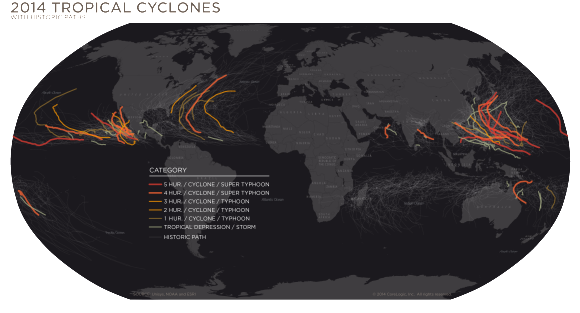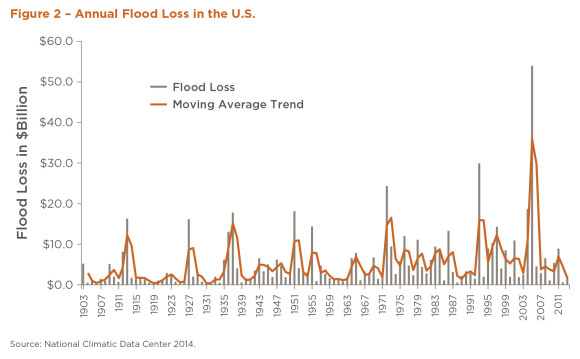This post is part of a series sponsored by CoreLogic.
Natural hazards continue to pose a significant risk to properties in the United States and abroad. As we near the close of 2014, it is important to take time to consider the number and severity of natural hazard events that occurred this past year, and to leverage that analysis to increase the understanding of and mitigation against significant hazard risk across the U.S. and around the world. The list of threatening natural hazards that impact properties and lives is long and varied, and includes hurricanes, tropical storms and cyclones, typhoons, flooding, hail and tornado events, wildfires, sinkholes and earthquakes. Each of these hazards can cause the loss of life as well as loss of property, and where they geographically occur is oftentimes more significant than the magnitude of the event.
Internationally, an array of hazard events including typhoons, extra-tropical hurricanes and hail events, as well as wildfires and earthquakes, impacted countries across the globe—from Taiwan to Germany and Canada to Australia. The most damaging of these were the Pacific-based storms that ravaged areas from Guam and the Philippines to China, Vietnam and Korea1. While Typhoons Neoguri (July), Matmo (July), and Hagupit (December) caused damage in the hundreds of millions of dollars, it was Typhoon Rammasun, also in July, that resulted in more than $7 billion in total damage1. All of the largest and most damaging ocean based storms in 2014 were located in the Pacific (Figure 1). While Pacific storms such as these have minimal impact on the U.S., they clearly demonstrate how natural hazards are a global phenomenon and can cause tremendous property loss in their wake.

Source: NOAA, ESRI and CoreLogic 2014.
Overall damage related to natural hazards in the United States in 2013 and continuing through 2014 was lower than expected and predicted2. Just as 2013 experienced a decline in the damage caused by major hazards in the U.S. when compared with 2012, this year experienced a continuation of similarly low overall damage totals3. Not since 2012 when Superstorm Sandy devastated parts of the Northeast coast, has the U.S. experienced a single natural hazard event causing damage in the tens of billions of dollars3. While a temporary reprieve from large destructive hazard events has occurred in the past, there has always been a return to more normal levels of hazard occurrence and the related damage they cause. Based on the historical record of hazard events, it is very unlikely that the two year reduction in damage in the U.S. will be a long-term trend.
If we look at the number of individual hazard events in the U.S. that totaled at least $1 billion in damage, there appears to be a short-term downward trend in recent years4. There were 14 events in 2011 that caused at least $1 billion in damage, followed by 11 events in 2012 and nine in 20134. That short-run decline in very costly hazard events will no doubt be reflected in the 2014 totals due to the relatively minimal damage that occurred this year. One major reason for the continued annual decline in very costly hazard-related damage in the U.S. is the fact that no major hurricanes made landfall along the Gulf or Atlantic coastlines in 2013 or 2014. Since land-falling hurricanes tend to be some of the most costly disasters historically, the lack of these events tends to substantially reduce the overall property loss for the year.
However, natural hazard damage is relative, and stating that 2014 was a “quiet” year in terms of loss does not mean that 2014 was without its share of damaging storms and hazard events. Even “quiet” years can result in locally devastating hazard events. Major record setting flood events occurred in California, Arizona and Michigan this year, with August floods devastating metropolitan Detroit and causing more than $1 billion in damages3. Record-setting rainfall totals in Phoenix, Islip, N.Y. and Los Angeles resulted in flash flooding, which exacerbated the damage totals in those cities as well3. In the case of Los Angeles, the flooding also caused devastating mudslides in and around some areas that were vulnerable due to recent wildfires, which had burned away vegetation that previously helped to stabilize the soil5.

Similarly, when the final number of tornado events are tallied, they will likely result in the fewest number of tornadoes in recent years6. Unfortunately, that has little bearing on the localized damage caused by these storms, such as the late April outbreak in Arkansas which produced an EF4 tornado that destroyed more than 400 homes and claimed 16 lives7. Also related to convective storms, hail damage tends to cause billions of dollars in damage annually in the U.S., partially due to the extensive geographic area that is susceptible to hail storms8. In the first 10 months of 2014, CoreLogic determined that 18.6 percent of the continental U.S. experienced hail that was 0.75 inches in diameter or larger9. A major hailstorm with large damaging hail swept through Blair, Neb. in early June and caused extensive damage10. One Blair automobile dealer reported an estimated $162 million in damage, with at least 4,300 cars dented or destroyed by the hail11.
In the case of earthquake activity and wildfires, both demonstrated relatively low impact during 2014. A M6.0 earthquake that occurred near Napa, Calif. damaged a number of historic buildings but overall had relatively minor impact on structures12. However, it had a much more severe impact on the wine industry with business interruption and lost inventory that will total in the hundreds of millions of dollars13. As for wildfires, the most damaging wildfire in 2014 occurred in the state of Washington where the Carlton Complex fire destroyed more than 300 homes in July14. It is obvious from these examples that even though 2014 experienced relatively few disasters, several of those that did occur were clearly very destructive. This is all the more reason to understand the geography of hazards and where they are most likely to pose a risk to lives and property.
It is impossible to accurately determine precisely where or when the next natural hazard event will strike. But it has been readily apparent for several consecutive years that the U.S. has had a slight reprieve from severely threatening catastrophic events. Although this temporary respite may continue for a while, it is unlikely to extend very far into the future. A more likely scenario would be a return to higher numbers and more damaging events. Given the fact that hazards will continue to cause property damage and loss of life in the U.S. and around the world, it is imperative to understand where these risks are most likely to occur, as well as the impact they may have.
Learn More
For more information about CoreLogic natural hazard risk data, or to download our 2014 Natural Hazard Risk Summary & Analysis, click here. You can also call us at (855)-267-7027 or email us at hazardrisk@corelogic.com.
CoreLogic (NYSE: CLGX) is a leading property information, analytics and services provider. The company’s combined public, contributory and proprietary data sources include over 3.3 billion records spanning more than 40 years. The company helps clients identify and manage growth opportunities, improve performance and mitigate risk. For more information visit www.corelogic.com.
SOURCES:
¹International Disaster Database: Disaster List, 2014.
²What Happened to the 2014 Atlantic Hurricane Season?, Jon Erdman, Weather.com, October, 2014 and NOAA U.S. Storm Event Database, 2014.
³NOAA U.S. Storm Event Database, 2014.
4NOAA Billion-Dollar Weather/Climate Disasters, 2014.
5Reuters: Pacific storm triggers mudslides, floods in Southern California, December, 2014.
6National Weather Service Storm Prediction Center, NOAA, 2014.
7National Weather Service Forecast Office, NOAA, Little Rock, AR, 2014.
8Rocky Mountain Insurance Information Association, 2014 (not on the old list)
9CoreLogic, 2014.
10Midwest Severe Weather: Hail Damages Nearly Entire Town of Blair, Nebraska, 2014.
11Expensive Hit: Hail Damages 4,300 Cars At Nebraska Dealership. WHOTV.com, 2014.
12Strongest earthquake in 25 years for California’s Bay Area. CNN, September 2014.
13Strongest earthquake in 25 years for California’s Bay Area. CNN, September 2014.
14Cost of Fighting Carlton Complex Hits $60 Million; 322 Destroyed, The Wenatchee World, 2014.
Topics California Trends Catastrophe USA Wildfire Flood Property Hurricane
Was this article valuable?
Here are more articles you may enjoy.



 UnitedHealth Says Hackers Possibly Stole Large Number of Americans’ Data
UnitedHealth Says Hackers Possibly Stole Large Number of Americans’ Data  Marsh McLennan Agency to Buy Fisher Brown Bottrell for About $316M
Marsh McLennan Agency to Buy Fisher Brown Bottrell for About $316M  Former Congressman Charged After Collision with State Trooper in Florida
Former Congressman Charged After Collision with State Trooper in Florida  Why New York’s Attorney General Objects to Trump’s Bond Insurer
Why New York’s Attorney General Objects to Trump’s Bond Insurer 

